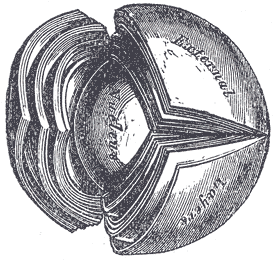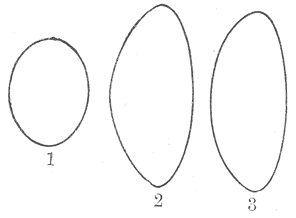The Refracting Media
Anatomy > Gray's Anatomy of the Human Body > X. The Organs of the Senses and the Common Integument > 1c. 2. The Refracting Media
Henry Gray (1821–1865). Anatomy of the Human Body. 1918.
The Refracting Media[edit | edit source]
The refracting media are three, viz.:
- Aqueous humor.
- Vitreous body.
- Crystalline lens.
The Aqueous Humor (humor aqueus)[edit | edit source]
The aqueous humor fills the anterior and posterior chambers of the eyeball. It is small in quantity, has an alkaline reaction, and consists mainly of water, less than one-fiftieth of its weight being solid matter, chiefly chloride of sodium.
The Vitreous Body (corpus vitreum)[edit | edit source]
The vitreous body forms about four-fifths of the bulb of the eye. It fills the concavity of the retina, and is hollowed in front, forming a deep concavity, the hyaloid fossa for the reception of the lens.
It is transparent, of the consistence of thin jelly, and is composed of an albuminous fluid enclosed in a delicate transparent membrane, the hyaloid membrane It has been supposed, by Hannover, that from its surface numerous thin lamellae are prolonged inward in a radiating manner, forming spaces in which the fluid is contained.
In the adult, these lamellae cannot be detected even after careful microscopic examination in the fresh state, but in preparations hardened in weak chromic acid it is possible to make out a distinct lamellation at the periphery of the body. In the center of the vitreous body, running from the entrance of the optic nerve to the posterior surface of the lens, is a canal, the hyaloid canal filled with lymph and lined by a prolongation of the hyaloid membrane.
This canal, in the embryonic vitreous body, conveyed the arteria hyaloidea from the central artery of the retina to the back of the lens. The fluid from the vitreous body is nearly pure water; it contains, however, some salts, and a little albumin.
The hyaloid membrane[edit | edit source]
The hyaloid membrane envelopes the vitreous body. The portion in front of the ora serrata is thickened by the accession of radial fibers and is termed the zonula ciliaris (zonule of Zinn). Here it presents a series of radially arranged furrows, in which the ciliary processes are accommodated and to which they adhere, as is shown by the fact that when they are removed some of their pigment remains attached to the zonula. The zonula ciliaris splits into two layers, one of which is thin and lines the hyaloid fossa; the other is named the suspensory ligament of the lens it is thicker, and passes over the ciliary body to be attached to the capsule of the lens a short distance in front of its equator.
Scattered and delicate fibers are also attached to the region of the equator itself. This ligament retains the lens in position, and is relaxed by the contraction of the meridional fibers of the Ciliaris muscle, so that the lens is allowed to become more convex.
Behind the suspensory ligament there is a sacculated canal, the spatia zonularis (canal of Petit), which encircles the equator of the lens; it can be easily inflated through a fine blowpipe inserted under the suspensory ligament. No bloodvessels penetrate the vitreous body, so that its nutrition must be carried on by vessels of the retina and ciliary processes, situated upon its exterior.
The Crystalline Lens (lens crystallina)[edit | edit source]
The crystalline lens, enclosed in its capsule, is situated immediately behind the iris, in front of the vitreous body, and encircled by the ciliary processes, which slightly overlap its margin.
The capsule of the lens[edit | edit source]
The capsule of the lens (capsula lentis) is a transparent, structureless membrane which closely surrounds the lens, and is thicker in front than behind. It is brittle but highly elastic, and when ruptured the edges roll up with the outer surface innermost. It rests, behind, in the hyaloid fossa in the forepart of the vitreous body; in front, it is in contact with the free border of the iris, but recedes from it at the circumference, thus forming the posterior chamber of the eye; it is retained in its position chiefly by the suspensory ligament of the lens, already described.
The lens[edit | edit source]
The lens is a transparent, biconvex body, the convexity of its anterior being less than that of its posterior surface. The central points of these surfaces are termed respectively the anterior and posterior poles a line connecting the poles constitutes the axis of the lens, while the marginal circumference is termed the equator
Structure[edit | edit source]
The lens is made up of soft cortical substance and a firm, central part, the nucleus (Fig. 884). Faint lines (radii lentis) radiate from the poles to the equator. In the adult there may be six or more of these lines, but in the fetus they are only three in number and diverge from each other at angles of 120° (Fig. 885); on the anterior surface one line ascends vertically and the other two diverge downward; on the posterior surface one ray descends vertically and the other two diverge upward.
They correspond with the free edges of an equal number of septa composed of an amorphous substance, which dip into the substance of the lens. When the lens has been hardened it is seen to consist of a series of concentrically arranged laminae, each of which is interrupted at the septa referred to.
Each lamina is built up of a number of hexagonal, ribbon-like lens fibers, the edges of which are more or less serrated—the serrations fitting between those of neighboring fibers, while the ends of the fibers come into apposition at the septa. The fibers run in a curved manner from the septa on the anterior surface to those on the posterior surface.
No fibers pass from pole to pole; they are arranged in such a way that those which begin near the pole on one surface of the lens end near the peripheral extremity of the plane on the other, and vice versa The fibers of the outer layers of the lens are nucleated, and together form a nuclear layer, most distinct toward the equator. The anterior surface of the lens is covered by a layer of transparent, columnar, nucleated epithelium. At the equator the cells become elongated, and their gradual transition into lens fibers can be traced (Fig. 887).
In the fetus the lens is nearly spherical, and has a slightly reddish tint; it is soft and breaks down readily on the slightest pressure. A small branch from the arteria centralis retinae runs forward, as already mentioned, through the vitreous body to the posterior part of the capsule of the lens, where its branches radiate and form a plexiform network, which covers the posterior surface of the capsule, and they are continuous around the margin of the capsule with the vessels of the pupillary membrane, and with those of the iris.
In the adult the lens is colorless, transparent, firm in texture, and devoid of vessels.
In old age it becomes flattened on both surfaces, slightly opaque, of an amber tint, and increased in density (Fig. 886).
Vessels and Nerves[edit | edit source]
The arteries of the bulb of the eye are the long, short, and anterior ciliary arteries, and the arteria centralis retinae. They have already been described (see p. 571).
The ciliary veins are seen on the outer surface of the choroid, and are named, from their arrangement, the venae vorticosae they converge to four or five equidistant trunks which pierce the sclera midway between the sclero-corneal junction and the porus opticus. Another set of veins accompanies the anterior ciliary arteries. All of these veins open into the ophthalmic veins.
The ciliary nerves are derived from the nasociliary nerve and from the ciliary ganglion.
Gray's Anatomy[edit source]
- Gray's Anatomy Contents
- Gray's Anatomy Subject Index
- About Classic Gray's Anatomy
- Glossary of anatomy terms
Anatomy atlases (external)[edit source]
[1] - Anatomy Atlases
| This article is a medical stub. You can help WikiMD by expanding it! | |
|---|---|
| Human systems and organs | ||||||||||||||
|---|---|---|---|---|---|---|---|---|---|---|---|---|---|---|
|
Search WikiMD
Ad.Tired of being Overweight? Try W8MD's physician weight loss program.
Semaglutide (Ozempic / Wegovy and Tirzepatide (Mounjaro / Zepbound) available.
Advertise on WikiMD
|
WikiMD's Wellness Encyclopedia |
| Let Food Be Thy Medicine Medicine Thy Food - Hippocrates |
Translate this page: - East Asian
中文,
日本,
한국어,
South Asian
हिन्दी,
தமிழ்,
తెలుగు,
Urdu,
ಕನ್ನಡ,
Southeast Asian
Indonesian,
Vietnamese,
Thai,
မြန်မာဘာသာ,
বাংলা
European
español,
Deutsch,
français,
Greek,
português do Brasil,
polski,
română,
русский,
Nederlands,
norsk,
svenska,
suomi,
Italian
Middle Eastern & African
عربى,
Turkish,
Persian,
Hebrew,
Afrikaans,
isiZulu,
Kiswahili,
Other
Bulgarian,
Hungarian,
Czech,
Swedish,
മലയാളം,
मराठी,
ਪੰਜਾਬੀ,
ગુજરાતી,
Portuguese,
Ukrainian
Medical Disclaimer: WikiMD is not a substitute for professional medical advice. The information on WikiMD is provided as an information resource only, may be incorrect, outdated or misleading, and is not to be used or relied on for any diagnostic or treatment purposes. Please consult your health care provider before making any healthcare decisions or for guidance about a specific medical condition. WikiMD expressly disclaims responsibility, and shall have no liability, for any damages, loss, injury, or liability whatsoever suffered as a result of your reliance on the information contained in this site. By visiting this site you agree to the foregoing terms and conditions, which may from time to time be changed or supplemented by WikiMD. If you do not agree to the foregoing terms and conditions, you should not enter or use this site. See full disclaimer.
Credits:Most images are courtesy of Wikimedia commons, and templates, categories Wikipedia, licensed under CC BY SA or similar.
Contributors: Deepika vegiraju, Prab R. Tumpati, MD





